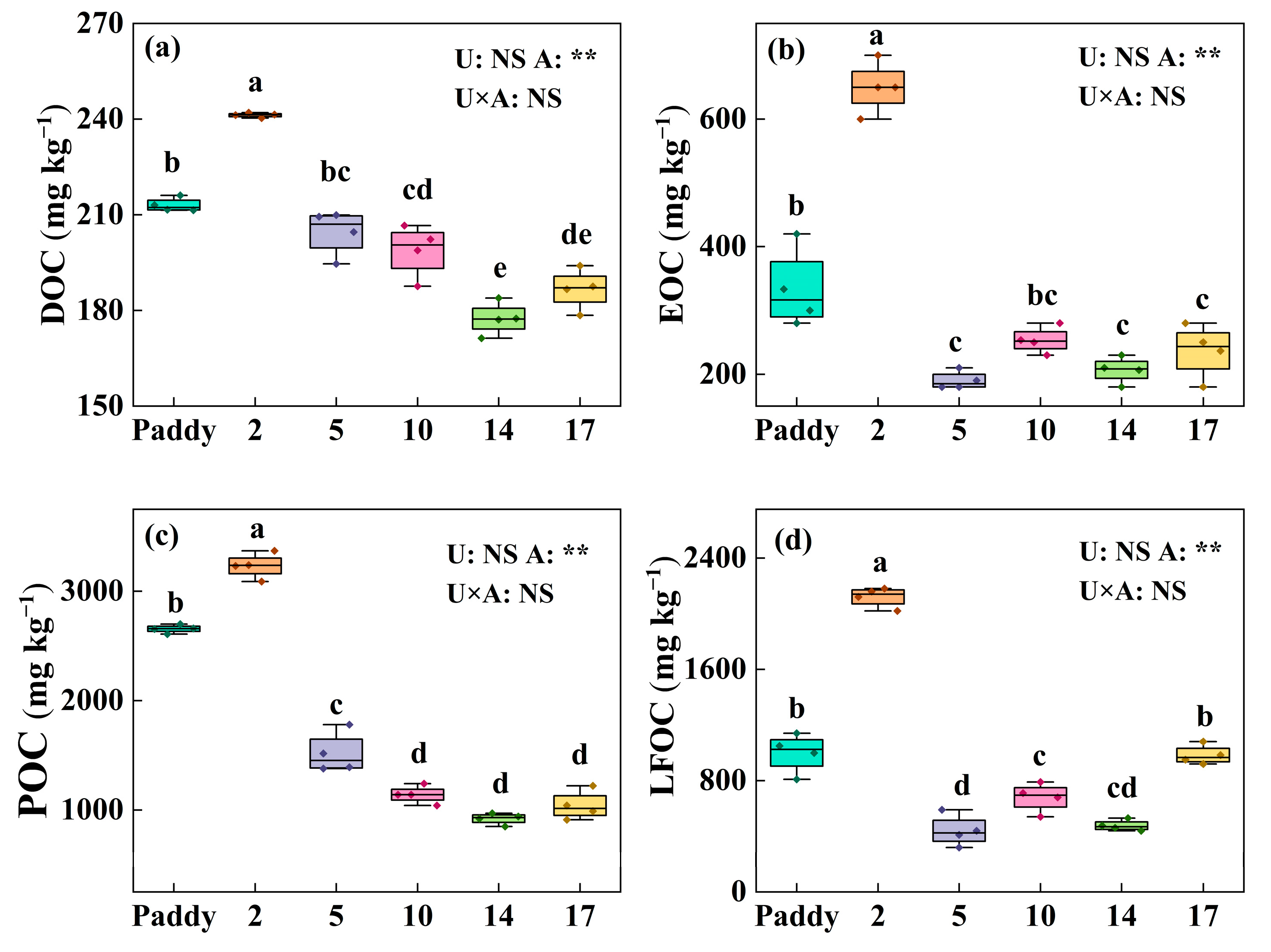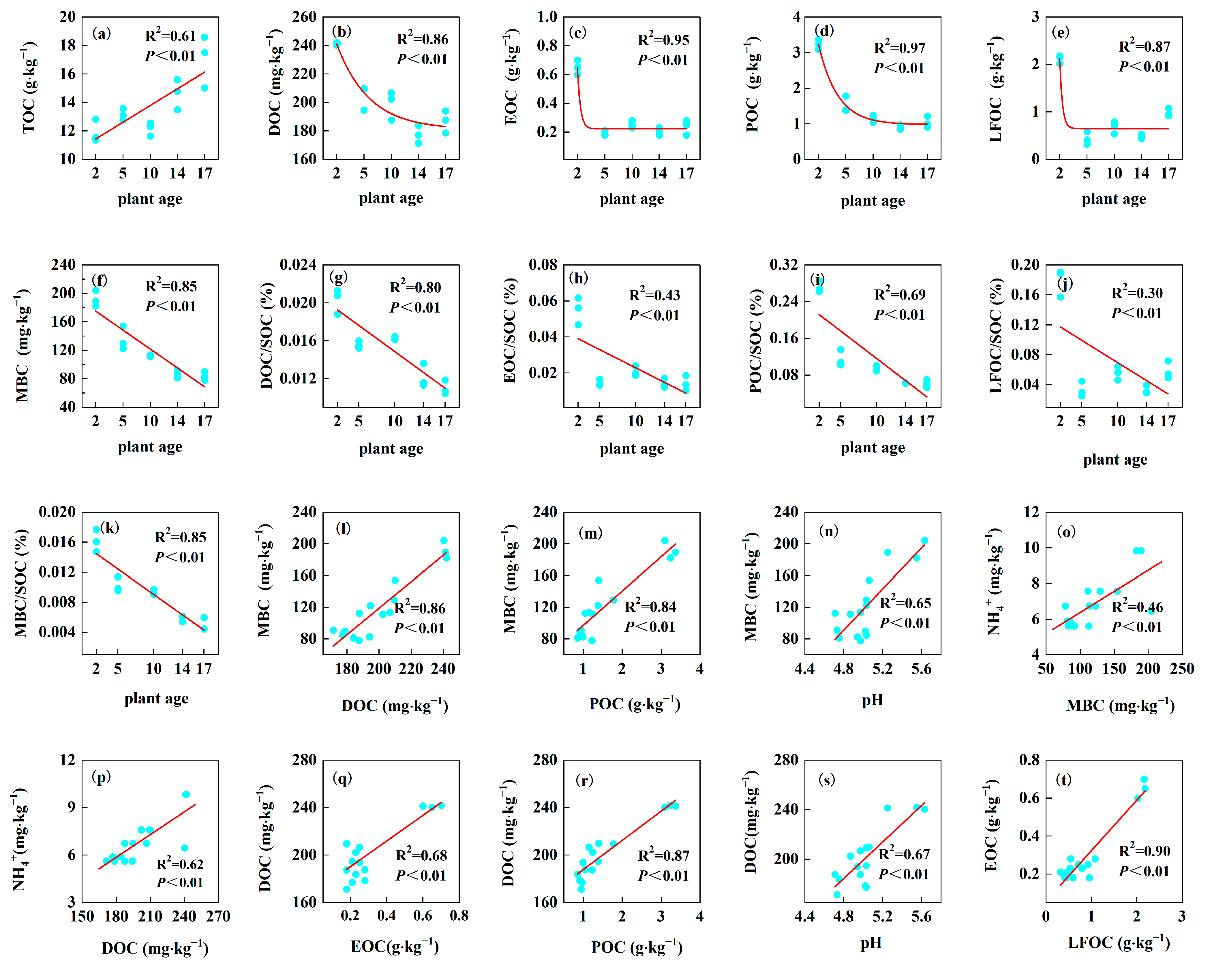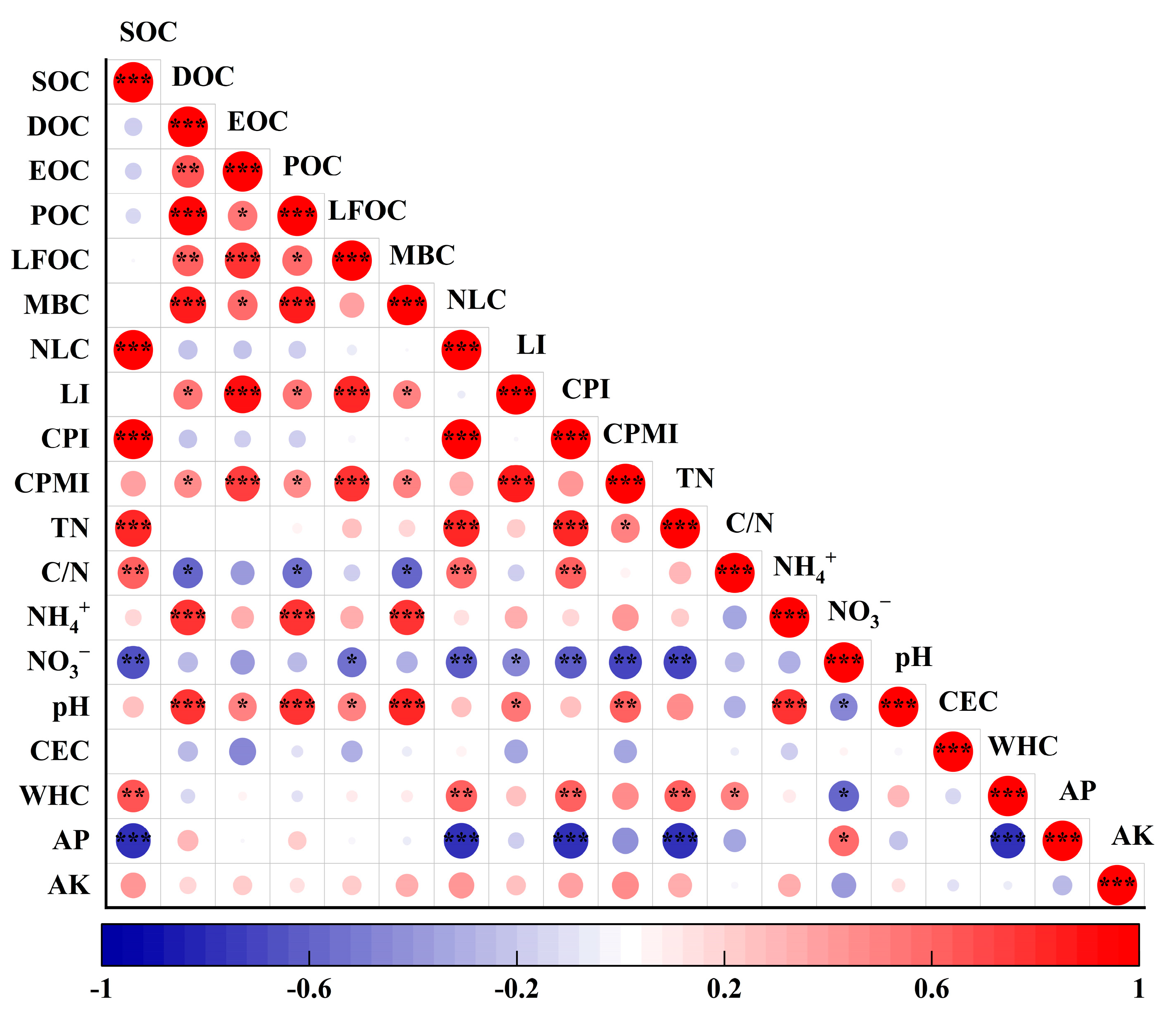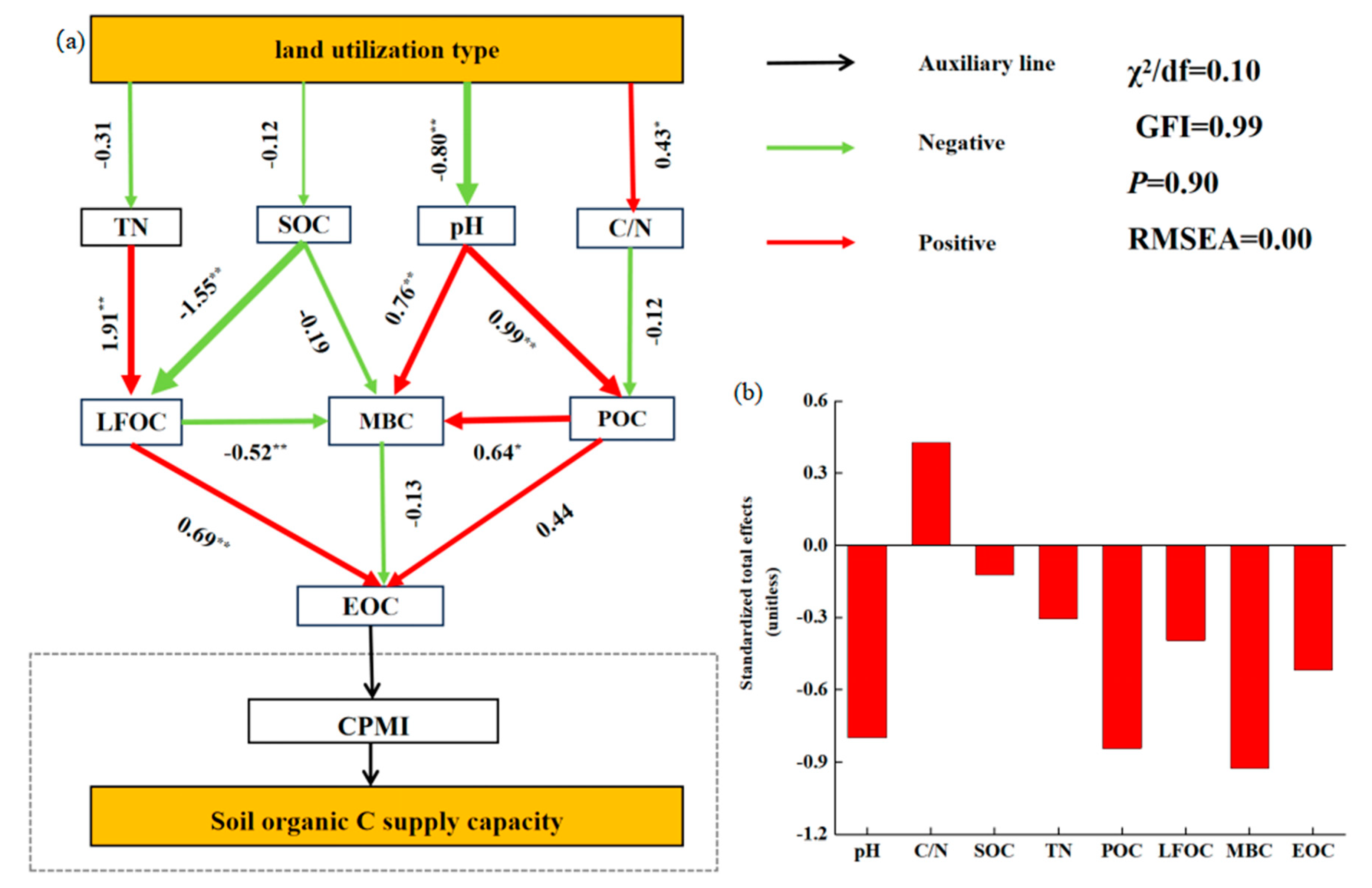Active Soil Organic Carbon Pools Decrease with Increased Time since Land-Use Transition from Rice Paddy Cultivation to Areca Nut Plantations under the Long-Term Application of Inorganic Fertilizer
Abstract
:1. Introduction
2. Materials and Methods
2.1. Soil Samples Site
2.2. Soil Properties Analysis
2.3. Determination of Soil Active Organic C
2.4. Calculation of the Soil Carbon Pool Management Index
2.5. Statistical Analysis
3. Results
3.1. Soil Physicochemical and Biological Properties
3.2. Active SOC Pools
3.3. Relationship between SOC and Its Fractions and Environmental Factors
3.4. Areca Nut Plantations Reduced Soil Organic C Supply Capacity
4. Discussion
5. Conclusions
Author Contributions
Funding
Data Availability Statement
Conflicts of Interest
References
- Salehi, B.; Konovalov, D.A.; Fru, P.; Kapewangolo, P.; Peron, G.; Ksenija, M.S.; Cardoso, S.M.; Pereira, O.R.; Nigam, M.; Nicola, S.; et al. Areca catechu—From farm to food and biomedical applications. Phytother. Res. 2020, 34, 2140–2158. [Google Scholar] [CrossRef]
- Yuan, J.; Zhang, H.; Zhao, H.; Ren, H.; Zhai, H. Study on Dissociation and Chemical Structural Characteristics of Areca Nut Husk. Molecules 2023, 28, 1513. [Google Scholar] [CrossRef]
- Lu, H.; Bai, Y.; Ren, H.; Campbell, D.E. Integrated emergy, energy and economic evaluation of rice and vegetable production systems in alluvial paddy fields: Implications for agricultural policy in China. J. Environ. Manag. 2010, 91, 2727–2735. [Google Scholar] [CrossRef]
- Zhu, Q.; Liu, L.; Li, K.; Wen, C.; Li, M.; Fan, C.; Zhu, T.; Shen, Q.; Wu, Y.; Tang, S.; et al. Decrease in soil inorganic nitrogen supply capacity under long-term areca nut plantations in the tropics. Land Degrad. Dev. 2022, 33, 3926–3937. [Google Scholar] [CrossRef]
- Dai, Z.; Fei, L.; Huang, D.; Zeng, J.; Chen, L.; Cai, Y. Coupling effects of irrigation and nitrogen levels on yield, water and nitrogen use efficiency of surge-root irrigated jujube in a semiarid region. Agric. Water Manag. 2019, 213, 146–154. [Google Scholar] [CrossRef]
- Choudhury, B.U.; Ansari, M.A.; Chakraborty, M.; Meetei, T.T. Effect of land-use change along altitudinal gradients on soil micronutrients in the mountain ecosystem of Indian (Eastern) Himalaya. Sci. Rep. 2021, 11, 14279. [Google Scholar] [CrossRef]
- Bhat, R.; Sujatha, S. Soil fertility and nutrient uptake by arecanut (Areca catechu L.) as affected by level and frequency of fertigation in a laterite soil. Agric. Water Manag. 2009, 96, 445–456. [Google Scholar] [CrossRef]
- Stockmann, U.; Adams, M.A.; Crawford, J.W.; Field, D.J.; Henakaarchchi, N.; Jenkins, M.; Minasny, B.; McBratney, A.B.; de Courcelles, V.d.R.; Singh, K.; et al. The knowns, known unknowns and unknowns of sequestration of soil organic carbon. Agric. Ecosyst. Environ. 2013, 164, 80–99. [Google Scholar] [CrossRef]
- Six, J.; Conant, R.T.; Paul, E.A.; Paustian, K. Stabilization mechanisms of soil organic matter: Implications for C-saturation of soils. Plant Soil 2002, 241, 155–176. [Google Scholar] [CrossRef]
- Zhang, Y.; Liao, X.; Wang, Z.; Wei, X.; Jia, X.; Shao, M. Synchronous sequestration of organic carbon and nitrogen in mineral soils after conversion agricultural land to forest. Agric. Ecosyst. Environ. 2020, 295, 106866. [Google Scholar] [CrossRef]
- Saha, S.K.; Ramachandran Nair, P.K.; Nair, V.D.; Kumar, B.M. Carbon storage in relation to soil size-fractions under tropical tree-based land-use systems. Plant Soil 2010, 328, 433–446. [Google Scholar] [CrossRef]
- Trost, B.; Ellmer, F.; Baumecker, M.; Meyer-Aurich, A.; Prochnow, A.; Drastig, K. Effects of irrigation and nitrogen fertilizer on yield, carbon inputs from above ground harvest residues and soil organic carbon contents of a sandy soil in Germany. Soil Use Manag. 2014, 30, 209–218. [Google Scholar] [CrossRef]
- Zhang, X.; Xiao, G.; Bol, R.; Wang, L.; Zhuge, Y.; Wu, W.; Li, H.; Meng, F. Influences of irrigation and fertilization on soil N cycle and losses from wheat–maize cropping system in northern China. Environ. Pollut. 2021, 278, 116852. [Google Scholar] [CrossRef]
- Dou, X.; He, P.; Cheng, X.; Zhou, W. Long-term fertilization alters chemically-separated soil organic carbon pools: Based on stable C isotope analyses. Sci. Rep. 2016, 6, 19061. [Google Scholar] [CrossRef] [PubMed]
- Jiang, Z.; Yang, S.; Ding, J.; Sun, X.; Chen, X.; Liu, X.; Xu, J. Modeling Climate Change Effects on Rice Yield and Soil Carbon under Variable Water and Nutrient Management. Sustainability 2021, 13, 568. [Google Scholar] [CrossRef]
- Li, Z.; Zhao, B.; Zhang, J. Effects of maize residue quality and soil water content on soil labile organic carbon fractions and microbial properties. Pedosphere 2016, 26, 829–838. [Google Scholar] [CrossRef]
- Duan, H.; Wang, L.; Zhang, Y.; Fu, X.; Tsang, Y.; Wu, J.; Le, Y. Variable decomposition of two plant litters and their effects on the carbon sequestration ability of wetland soil in the Yangtze River estuary. Geoderma 2018, 319, 230–238. [Google Scholar] [CrossRef]
- Shi, A.; Yan, N.; Marschner, P. Cumulative respiration in two drying and rewetting cycles depends on the number and distribution of moist days. Geoderma 2015, 243–244, 168–174. [Google Scholar] [CrossRef]
- Bao, S.D. Soil and Agricultural Chemistry Analysis; China Agricultural Press: Beijing, China, 2000. [Google Scholar]
- Vance, E.D.; Brookes, P.C.; Jenkinson, D.S. An extraction method for measuring soil microbial biomass C. Soil Biol. Biochem. 1987, 19, 703–707. [Google Scholar] [CrossRef]
- Zsolnay, Á. Dissolved organic matter: Artefacts, definitions, and functions. Geoderma 2003, 113, 187–209. [Google Scholar] [CrossRef]
- Gregorich, E.G.; Janzen, H.H. Storage of soil carbon in the light fraction and macroorganic matter. In Structure and Organic Matter Storage in Agricultural Soils; CRC Press: Boca Raton, FL, USA, 2020; pp. 167–190. [Google Scholar]
- Gu, C.; Liu, Y.; Mohamed, I.; Zhang, R.; Wang, X.; Nie, X.; Jiang, M.; Brooks, M.; Chen, F.; Li, Z. Dynamic changes of soil surface organic carbon under different mulching practices in citrus orchards on sloping land. PLoS ONE 2016, 11, e0168384. [Google Scholar] [CrossRef]
- Cambardella, C.A.; Elliott, E.T. Particulate Soil Organic-Matter Changes across a Grassland Cultivation Sequence. Soil Sci. Soc. Am. J. 1992, 56, 777–783. [Google Scholar] [CrossRef]
- Huang, B.; Zhang, L.; Cao, Y.; Yang, Y.; Ping, W.; Li, Z.; Lin, Y. Effects of land-use type on soil organic carbon and carbon pool management index through arbuscular mycorrhizal fungi pathways. Glob. Ecol. Conserv. 2023, 43, e02432. [Google Scholar] [CrossRef]
- Zhang, Y.F.; Zhao, S.W.; Li, X.X.; Luo, Z.D.; Wang, Z.L. The influence of aggregate stability and characteristics of SOC functional groups in anthropogenic-alluvial soil under different land use patterns. J. Soil Water Conserv. 2015, 29, 169–174. [Google Scholar]
- Liao, H.; Long, J.; Li, J. Conversion of cropland to Chinese prickly ash orchard affects soil organic carbon dynamics in a karst region of southwest China. Nutr. Cycl. Agroecosystems 2016, 104, 15–23. [Google Scholar] [CrossRef]
- Kindler, R.; Siemens, J.A.N.; Kaiser, K.; Walmsley, D.C.; Bernhofer, C.; Buchmann, N.; Cellier, P.; Eugster, W.; Gleixner, G.; Grũnwald, T.; et al. Dissolved carbon leaching from soil is a crucial component of the net ecosystem carbon balance. Glob. Chang. Biol. 2011, 17, 1167–1185. [Google Scholar] [CrossRef]
- Liao, L.; Wang, J.; Lei, S.; Zhang, L.; Ye, Z.; Liu, G.; Zhang, C. Differential effects of nitrogen addition on the organic carbon fractions of rhizosphere and bulk soil based on a pot experiment. J. Soils Sediments 2023, 23, 103–117. [Google Scholar] [CrossRef]
- Liu, F.; Qin, S.; Fang, K.; Chen, L.; Peng, Y.; Smith, P.; Yang, Y. Divergent changes in particulate and mineral-associated organic carbon upon permafrost thaw. Nat. Commun. 2022, 13, 5073. [Google Scholar] [CrossRef] [PubMed]
- Yang, X.; Meng, J.; Lan, Y.; Chen, W.; Yang, T.; Yuan, J.; Liu, S.; Han, J. Effects of maize stover and its biochar on soil CO2 emissions and labile organic carbon fractions in Northeast China. Agric. Ecosyst. Environ. 2017, 240, 24–31. [Google Scholar] [CrossRef]
- Han, X.; Liu, X.; Li, Z.; Li, J.; Yuan, Y.; Li, H.; Zhang, L.; Liu, S.; Wang, L.; You, C.; et al. Characteristics of Soil Organic Carbon Fractions and Stability along a Chronosequence of Cryptomeria japonica var. sinensis Plantation in the Rainy Area of Western China. Forests 2022, 13, 1663. [Google Scholar] [CrossRef]
- Wang, Y.; Gao, S.; Li, C.; Zhang, J.; Wang, L. Effects of temperature on soil organic carbon fractions contents, aggregate stability and structural characteristics of humic substances in a Mollisol. J. Soils Sediments 2016, 16, 1849–1857. [Google Scholar] [CrossRef]
- Baude, M.; Meyer, B.C.; Schindewolf, M. Land use change in an agricultural landscape causing degradation of soil based ecosystem services. Sci. Total. Environ. 2019, 659, 1526–1536. [Google Scholar] [CrossRef] [PubMed]
- Yuan, G.; Huan, W.; Song, H.; Lu, D.; Chen, X.; Wang, H.; Zhou, J. Effects of straw incorporation and potassium fertilizer on crop yields, soil organic carbon, and active carbon in the rice–wheat system. Soil Tillage Res. 2021, 209, 104958. [Google Scholar] [CrossRef]
- Chen, X.; Liu, J.; Deng, Q.; Yan, J.; Zhang, D. Effects of elevated CO2 and nitrogen addition on soil organic carbon fractions in a subtropical forest. Plant Soil 2012, 357, 25–34. [Google Scholar] [CrossRef]
- Wang, L.; Gao, C.; Yang, K.; Sheng, Y.; Xu, J.; Zhao, Y.; Lou, J.; Sun, R.; Zhu, L. Effects of biochar aging in the soil on its mechanical property and performance for soil CO2 and N2O emissions. Sci. Total Environ. 2021, 782, 146824. [Google Scholar] [CrossRef] [PubMed]
- McLatchey, G.P.; Reddy, K.R. Regulation of Organic Matter Decomposition and Nutrient Release in a Wetland Soil. J. Environ. Qual. 1998, 27, 1268–1274. [Google Scholar] [CrossRef]
- He, H.; Peng, M.; Lu, W.; Ru, S.; Hou, Z.; Li, J. Organic fertilizer substitution promotes soil organic carbon sequestration by regulating permanganate oxidizable carbon fractions transformation in oasis wheat fields. Catena 2023, 221, 106784. [Google Scholar] [CrossRef]
- Cavalieri, K.M.V.; da Silva, A.P.; Tormena, C.A.; Leão, T.P.; Dexter, A.R.; Håkansson, I. Long-term effects of no-tillage on dynamic soil physical properties in a Rhodic Ferrasol in Paraná, Brazil. Soil Tillage Res. 2009, 103, 158–164. [Google Scholar] [CrossRef]
- Lin, S.; Wang, W.; Vancov, T.; Lai, D.Y.F.; Wang, C.; Wiesmeier, M.; Jin, Q.; Liu, X.; Fang, Y. Soil carbon, nutrients and their stoichiometry decrement in relation to paddy field degradation: Investigation in a subtropical region. Catena 2022, 217, 106484. [Google Scholar] [CrossRef]
- García-Campos, E.; Zorita, F.; Leirós, M.C.; Gil-Sotres, F.; Trasar-Cepeda, C. Evaluation of C Stocks in Afforested High Quality Agricultural Land. Forests 2022, 13, 2055. [Google Scholar] [CrossRef]




| Land Use | Urea | Super-Phosphate | Potassium Oxide | Rice Straw |
|---|---|---|---|---|
| (kg ha−1 y−1) | (kg ha−1 y−1) | (kg ha−1 y−1) | (kg ha−1 y−1) | |
| Paddy | 180–200 | 80–100 | 150–200 | 1000–2000 |
| A2 | 350–400 | 220–260 | 200–250 | without |
| A5 | 350–400 | 220–260 | 200–250 | without |
| A10 | 350–400 | 220–260 | 200–250 | without |
| A14 | 350–400 | 220–260 | 200–250 | without |
| A17 | 350–400 | 220–260 | 200–250 | without |
| Parameter | Paddy | A2 | A5 | A10 | A14 | A17 |
|---|---|---|---|---|---|---|
| SOC (g C kg−1) | 20.87 ± 0.41 a | 11.92 ± 0.65 d | 13.14 ± 0.33 cd | 12.16 ± 0.38 d | 14.63 ± 0.87 c | 17.05 ± 1.49 b |
| TN (g N kg−1) | 1.92 ± 0.05 a | 1.26 ± 0.17 c | 1.22 ± 0.02 c | 1.15 ± 0.05 c | 1.31 ± 0.07 c | 1.51 ± 0.11 b |
| C/N | 10.86 ± 0.08 ab | 9.60 ± 1.42 b | 10.75 ± 0.08 ab | 10.6 ± 0.36 ab | 11.20 ± 0.07 a | 11.26 ± 0.19 a |
| NH4+ (mg kg−1) | 15.46 ± 1.00 a | 8.71 ± 1.59 b | 7.31 ± 0.40 bc | 6.65 ± 0.81 c | 5.81 ± 0.13 c | 5.99 ± 0.53 c |
| NO3− (mg kg−1) | 3.93 ± 0.4 c | 8.86 ± 0.35 bc | 12.27 ± 2.54 ab | 16.49 ± 3.79 a | 11.33 ± 3.13 ab | 5.34 ± 0.23 c |
| pH | 5.8 ± 0.01 a | 5.48 ± 0.16 b | 5.04 ± 0.01 c | 4.68 ± 0.16 c | 4.84 ± 0.14 c | 5.34 ± 0.23 c |
| CEC (mmol kg−1) | 4.03 ± 2.61 a | 3.99 ± 2.50 a | 4.75 ± 1.31 a | 3.88 ±7.71 a | 4.03 ± 5.04 a | 4.39 ± 6.41 a |
| AP (mg kg−1) | 34.78 ± 7.67 c | 119.20 ± 11.8 a | 116.89 ± 9.86 a | 127.37 ± 6.67 a | 79.13 ± 4.92 b | 87.50 ± 6.11 b |
| AK (mg kg−1) | 392.30 ± 0.00 a | 146.39 ± 2.43 d | 146.13 ± 6.28 d | 260.03 ± 14.4 b | 134.34 ± 28.4 d | 180.89 ± 8.88 c |
| MBC (mg kg−1) | 242.31 ± 10.1 a | 191.94 ± 9.17 b | 135.27 ± 13.7 c | 112.61 ± 0.94 d | 85.84 ± 4.15 e | 83.62 ± 4.89 e |
| MBN (mg kg−1) | 35.11 ± 4.11 a | 23.76 ± 4.37 d | 19.93 ± 4.94 bc | 14.36 ± 0.83 cd | 11.97 ± 0.55 d | 11.22 ± 0.94 d |
| Parameter | POC/SOC | EOC/SOC | DOC/SOC | LFOC/SOC | MBC/SOC |
|---|---|---|---|---|---|
| Paddy | 12.73 ± 0.14 b | 1.60 ± 0.34 b | 1.02 ± 0.02 d | 4.80 ± 0.84 bc | 1.16 ± 0.04 b |
| A2 | 27.18 ± 1.20 a | 5.49 ± 0.75 a | 2.03 ± 0.13 a | 17.88 ± 1.85 a | 1.62 ± 0.15 a |
| A5 | 11.55 ± 1.80 b | 1.45 ± 0.17 b | 1.56 ± 0.04 b | 3.35 ± 1.04 c | 1.03 ± 0.10 bc |
| A10 | 9.37 ± 0.62 c | 2.09 ± 0.28 b | 1.63 ± 0.02 b | 5.57 ± 0.89 b | 0.93 ± 0.04 c |
| A14 | 6.29 ± 0.07 d | 1.42 ± 0.25 b | 1.21 ± 0.12 cd | 3.28 ± 0.56 c | 0.59 ± 0.04 d |
| A17 | 6.12 ± 0.82 d | 1.41 ± 0.42 b | 1.41 ± 0.08 c | 5.85 ± 1.18 b | 0.50 ± 0.09 d |
| Parameter | NLC (g C kg−1) | L | LI | CPI | CPMI |
|---|---|---|---|---|---|
| Paddy | 20.54 ± 0.48 a | 6.85 ± 1.62 a | 1.00 ± 0.00 a | 1.00 ± 0.00 a | 100.00 ± 0.00 a |
| A2 | 11.27 ± 0.85 d | 7.30 ± 0.19 a | 1.10 ± 0.25 a | 0.57 ± 0.03 d | 63.39 ± 16.8 b |
| A5 | 12.95 ± 0.42 cd | 2.46 ± 0.16 c | 0.37 ± 0.08 b | 0.63 ± 0.01 bc | 23.33 ± 5.11 d |
| A10 | 11.91 ± 0.49 d | 3.01 ± 0.21 bc | 0.46 ± 0.12 b | 0.58 ± 0.03 d | 26.70 ± 7.18 d |
| A14 | 14.42 ± 1.08 c | 2.97 ± 0.31 bc | 0.45 ± 0.09 b | 0.70 ± 0.07 c | 31.73 ± 9.62 cd |
| A17 | 14.42 ± 1.85 b | 3.95 ± 0.75 b | 0.58 ± 0.09 b | 0.82 ± 0.07 b | 47.13 ± 3.50 c |
Disclaimer/Publisher’s Note: The statements, opinions and data contained in all publications are solely those of the individual author(s) and contributor(s) and not of MDPI and/or the editor(s). MDPI and/or the editor(s) disclaim responsibility for any injury to people or property resulting from any ideas, methods, instructions or products referred to in the content. |
© 2024 by the authors. Licensee MDPI, Basel, Switzerland. This article is an open access article distributed under the terms and conditions of the Creative Commons Attribution (CC BY) license (https://creativecommons.org/licenses/by/4.0/).
Share and Cite
Wan, Y.; Zhu, Q.; Liu, L.; Tang, S.; Wu, Y.; Dan, X.; Meng, L.; He, Q.; Elrys, A.S.; Zhang, J. Active Soil Organic Carbon Pools Decrease with Increased Time since Land-Use Transition from Rice Paddy Cultivation to Areca Nut Plantations under the Long-Term Application of Inorganic Fertilizer. Agronomy 2024, 14, 946. https://doi.org/10.3390/agronomy14050946
Wan Y, Zhu Q, Liu L, Tang S, Wu Y, Dan X, Meng L, He Q, Elrys AS, Zhang J. Active Soil Organic Carbon Pools Decrease with Increased Time since Land-Use Transition from Rice Paddy Cultivation to Areca Nut Plantations under the Long-Term Application of Inorganic Fertilizer. Agronomy. 2024; 14(5):946. https://doi.org/10.3390/agronomy14050946
Chicago/Turabian StyleWan, Yunxing, Qilin Zhu, Lijun Liu, Shuirong Tang, Yanzheng Wu, Xiaoqian Dan, Lei Meng, Qiuxiang He, Ahmed S. Elrys, and Jinbo Zhang. 2024. "Active Soil Organic Carbon Pools Decrease with Increased Time since Land-Use Transition from Rice Paddy Cultivation to Areca Nut Plantations under the Long-Term Application of Inorganic Fertilizer" Agronomy 14, no. 5: 946. https://doi.org/10.3390/agronomy14050946
APA StyleWan, Y., Zhu, Q., Liu, L., Tang, S., Wu, Y., Dan, X., Meng, L., He, Q., Elrys, A. S., & Zhang, J. (2024). Active Soil Organic Carbon Pools Decrease with Increased Time since Land-Use Transition from Rice Paddy Cultivation to Areca Nut Plantations under the Long-Term Application of Inorganic Fertilizer. Agronomy, 14(5), 946. https://doi.org/10.3390/agronomy14050946







